Comet lovers have much to look forward to this year, with six potential binocular comets in 2017 and at least two others for modest backyard telescopes.
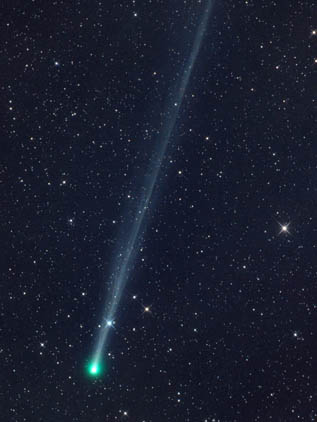
Gerald Rhemann
If you don't own binoculars, get a pair soon. I've gone over my list, checked it thrice, and come up with six likely binocular comets making appearances in 2017. At least one of these could reach naked-eye visibility.
The first of the comets in 2017 is returning periodic comet 45P/Honda-Mrkos-Pajdusakova, currently painfully low in the southwestern sky in late evening twilight but mustering a healthy magnitude +7. Several observers have reported seeing it with binoculars this past week, including amateur Scott Harrington of Arkansas who spotted it in a pair of 7×35s.
Due to clouds, my last observation was made two weeks ago. Then the comet appeared bright and well-condensed with a beautiful aqua-hued coma in a 15-inch reflector magnifying 64×.
Binocular Bonanza for Comets in 2017
As reported in an earlier blog, Comet 45P/H-M-P will show best in the early morning just before the start of dawn in February, when it could top out around magnitude +6.5. It will also be much easier to see, streaking from Hercules through Boötes over just a couple days as it makes an exceptionally close approach to Earth.
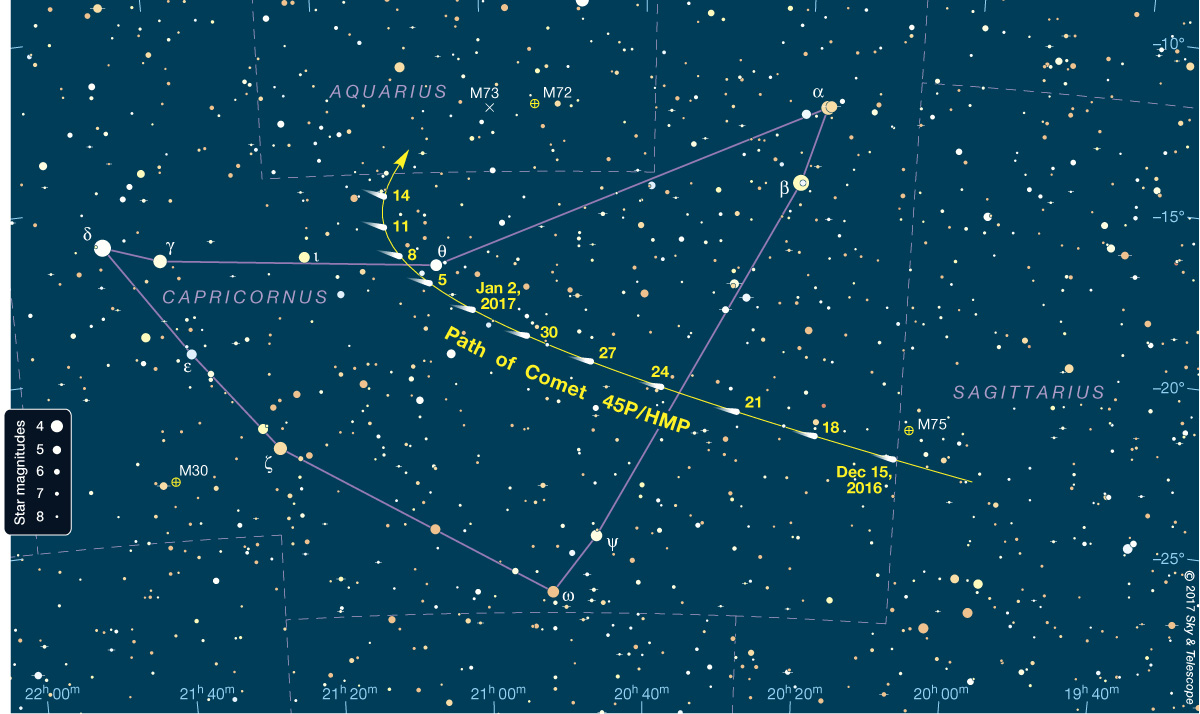
Sky & Telescope
I hope you like getting up early because this week and early next will be your last chances to catch 8th-magnitude comet NEOWISE (C/2016 U1). Discovered last fall, this initially diffuse object has steadily brightened to become more compact and luminous to the point that it's now observable in small telescopes and even binoculars from a dark sky.
Get out there soon! The comet is sinking fast into the dawn glow, with only about a week left in its northern apparition. In late February, it might be glimpsed again around 12th magnitude low in the west at dusk but only from the southern hemisphere. With an orbital period of thousands of years, no one alive today will witness its next return. Sniff.
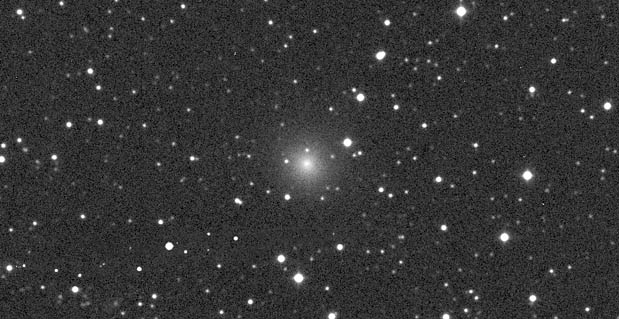
Michael Jaeger
C/2016 U1 responds well to a Swan Band filter, an accessory every serious comet observer should have. It blocks unwanted light while enhancing fluorescing molecular carbon gases in a comet's coma. Some comets produce a lot of gas and respond very well to the filter; others are less gassy and show little change in contrast. For a gassy comet at low altitude, the filter can be make the difference between seeing it or not.
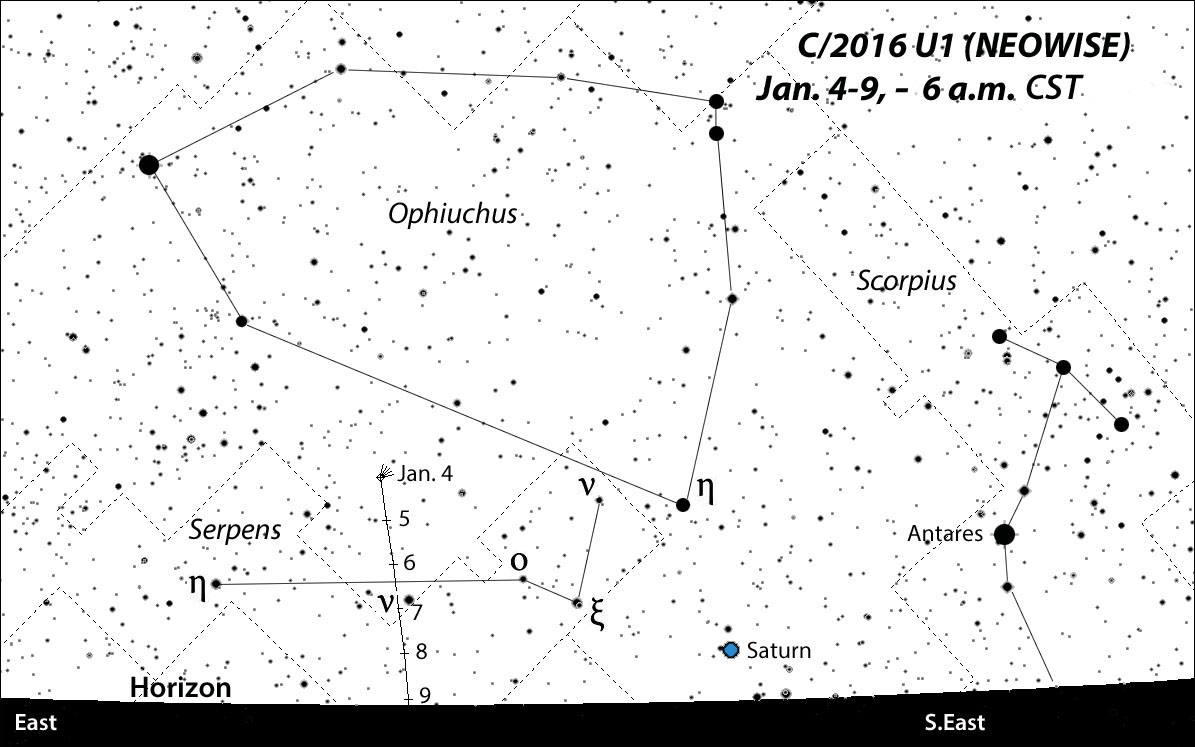
Source: Chris Marriott's SkyMap software with additions by the author (all B&W maps)
Periodic comets, those that lap the Sun in fewer than 200 years, are well represented among the comets in 2017. Next in line is the dashing little fuzzball 2P/Encke, which completes an orbit in a hurry, just 3.3 years. Encke always begins its apparition as a faint, diffuse mist but wastes no time brightening and compacting into a fine little comet suitable for small telescopes.
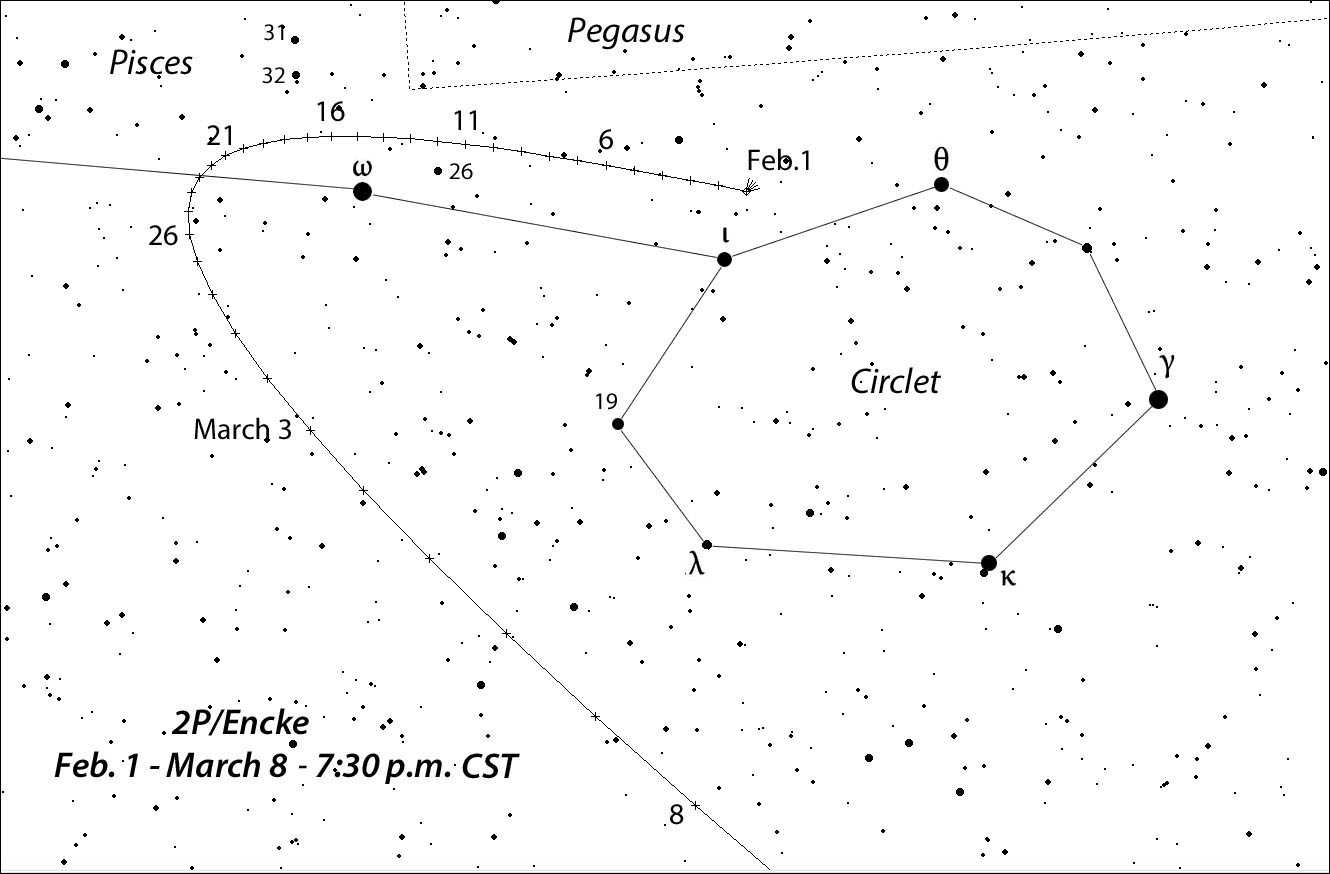
Source: Chris Marriott's SkyMap software
The comet was recently snared by visual comet observers in December, but it still shines wanly at magnitude +12 at this writing. Watch for it to brighten to magnitude +9 by mid-February as it cracks the whip around the Circlet asterism in Pisces at nightfall. Soon after, Comet Encke plunges south and becomes lost in evening twilight by early to mid-March even as it swells to a predicted magnitude of ~6.5. Just so we don't lose count, that's already three binocular comets and we're barely halfway through our list.
Comets in 2017: Keep 'em Comin'
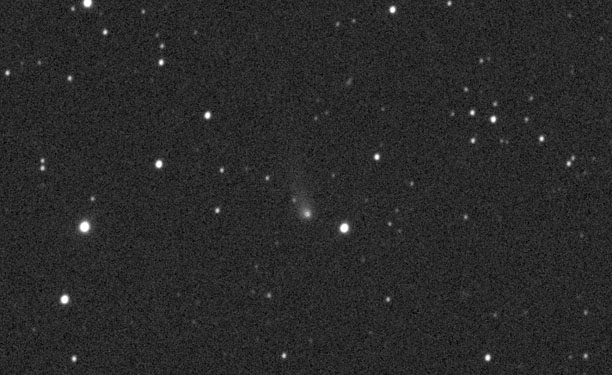
Joseph Brimacombe
Eager for more comets in 2017? Pull closer to the table. The next comet, PanSTARRS (C/2015 ER61), has created a flurry of excitement with some estimating its peak magnitude as bright as +2. Discovered as an asteroid in 2015, it was later shown to exhibit a coma and renamed as a comet. Most sources I've checked, including Seiichi Yoshida's excellent Weekly Bright Comets and JPL's Horizon site, put C/2015 ER61 at magnitude +7 from mid-April through mid-May. No complaints here. Any comet visible in binoculars is a gift, and every one of them looks even more amazing in a telescope.
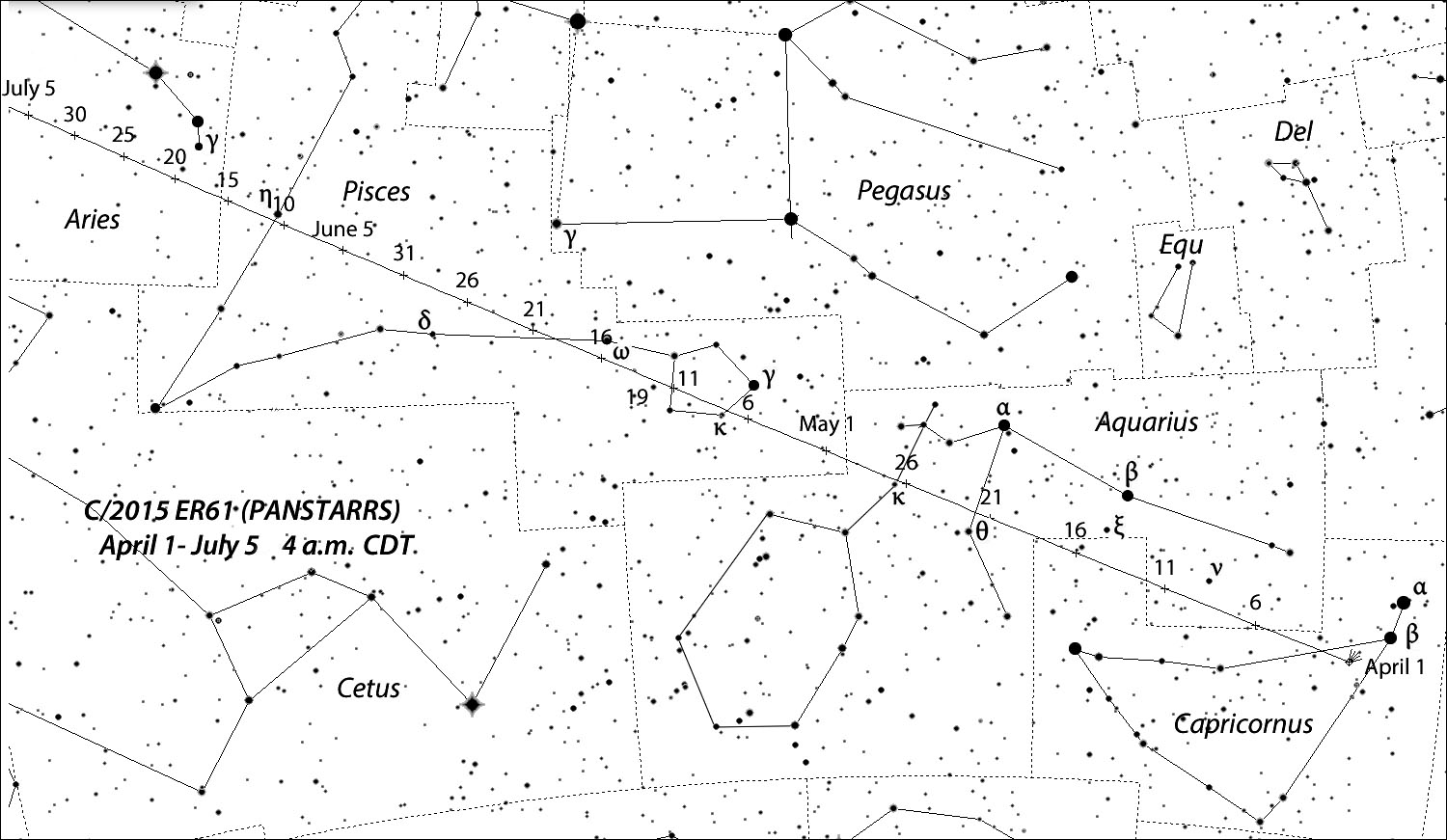
Source: Chris Marriott's SkyMap software
Still, some may struggle to find this cotton ball. Why? C/2015 ER61 has a serious altitude problem for observers at mid-northern latitudes throughout its apparition. The comet tracks along the ecliptic never far behind the Sun. This month, the 30″ diameter, 13th-magnitude comet creeps from Libra into Scorpius, keeping observers at bay until the very start of dawn, when it finally reaches a somewhat reasonable height above the horizon. When brightest in May, it will be crossing from Aquarius to Pisces.
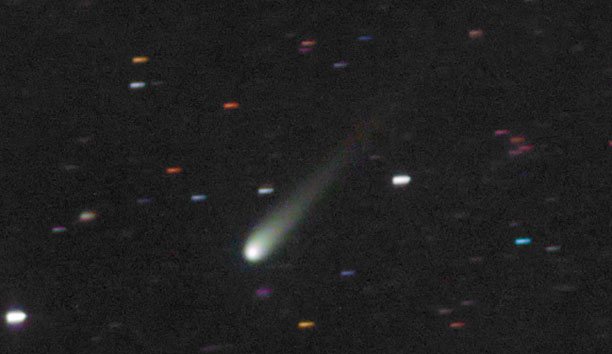
Chris Schur
I've got high hopes for a relative newcomer to the comet scene, Johnson (C/2015 V2), which may peak around magnitude +6.5 in early June as it slides down the eastern side of Boötes high in the southern sky before the mosquitoes return. Currently at magnitude +11.5, 1′ in diameter and moderately condensed, this comet is warming up for its spring performance in the morning sky in northern Boötes. An 8-incher should coax it into view using magnifications of 100× and higher.
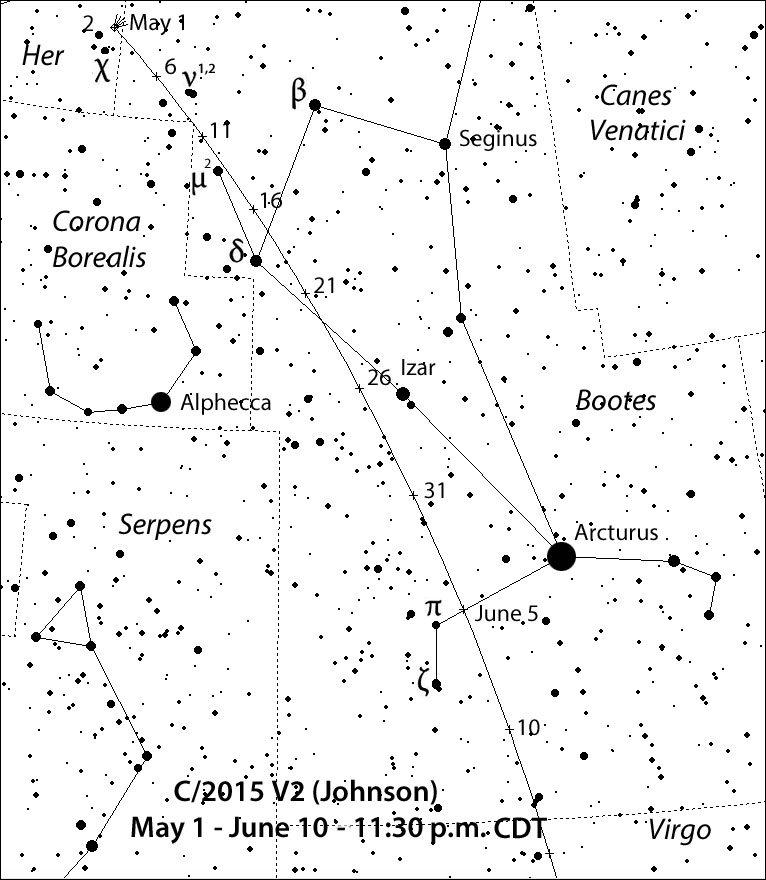
Source: Chris Marriott's SkyMap software
By the way, if you lack the software to create a comet path, you can always download the latest version of the free program Stellarium for Windows or Mac and pinpoint this and any other comet's position one night at a time, as well as other comets' paths. To ensure you have all the stars you need (down to magnitude 14 and fainter), click on the Configuration tab on the left side of your screen, select Tools, then download Star Catalog Updates.
Update March 16, 2017: Use the finder chart for Comet T-G-K here (the ticks are for 9 p.m. EDT = 1h UT on the following date). The earlier chart that appeared with this article, which is also printed in the May 2017 Sky & Telescope, is significantly wrong due to a change in the ephemeris.
I saved what might become the brightest comet of 2017 for last: 41P/Tuttle-Giacobini-Kresak. We touched on this one in a blog last November as one of the three periodic comets that are making extremely close passes of Earth in the next two years. Come April, as it tears across the northern circumpolar sky, it may max out at magnitude +6 and become faintly visible with the naked eye under rural skies. While that's exciting enough to contemplate, this comet is known for outrageous outbursts. Twice in 1973 it underwent 10-magnitude eruptions! More recently, in December 2001, it shot up three magnitudes unexpectedly. Watch out for this live wire!
Fainter Fuzzies
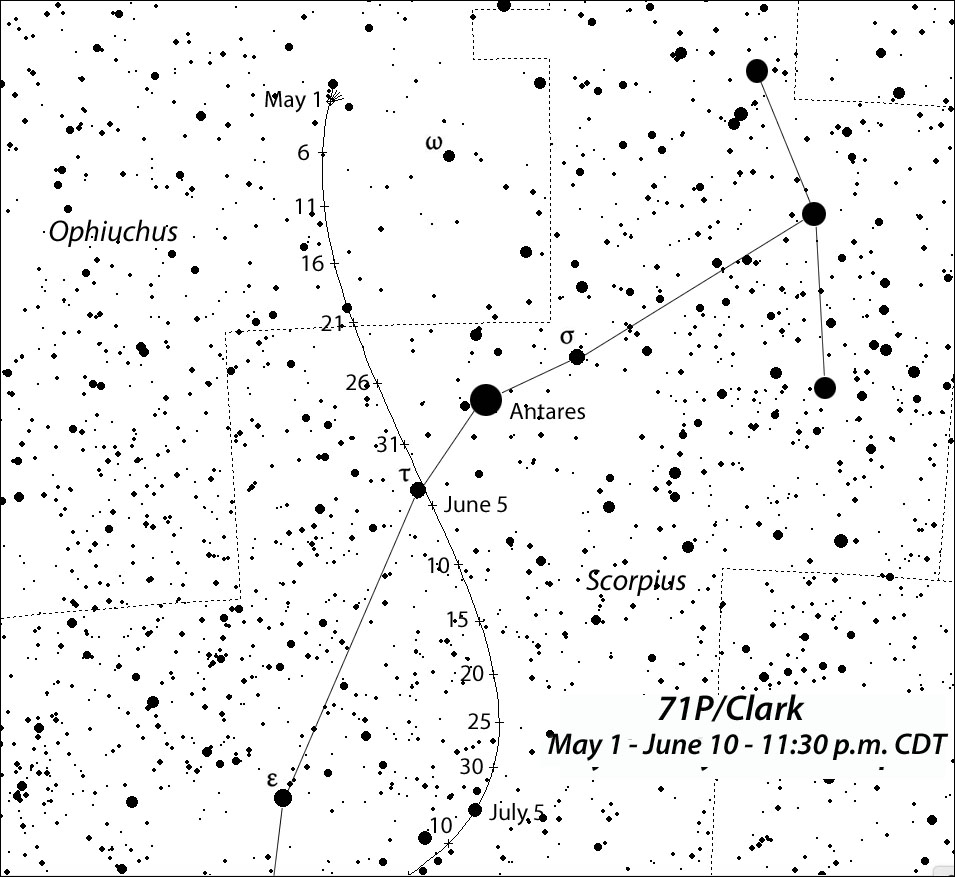
Source: Chris Marriott's SkyMap software
As if that's not enough, two other fainter comets in 2017 will help to fill in any gaps, making sure no one goes home cometless in 2017. They're both periodic: 71P/Clark and 24P/Schaumasse. Clark could reach magnitude +10 from mid-June to early July as it describes a lazy S through Scorpius. Southern Hemisphere observers are favored, but the comet will still be high enough to catch from mid-northern latitudes during its brightest period. In late May, watch for it to pass just 2° east of Antares.
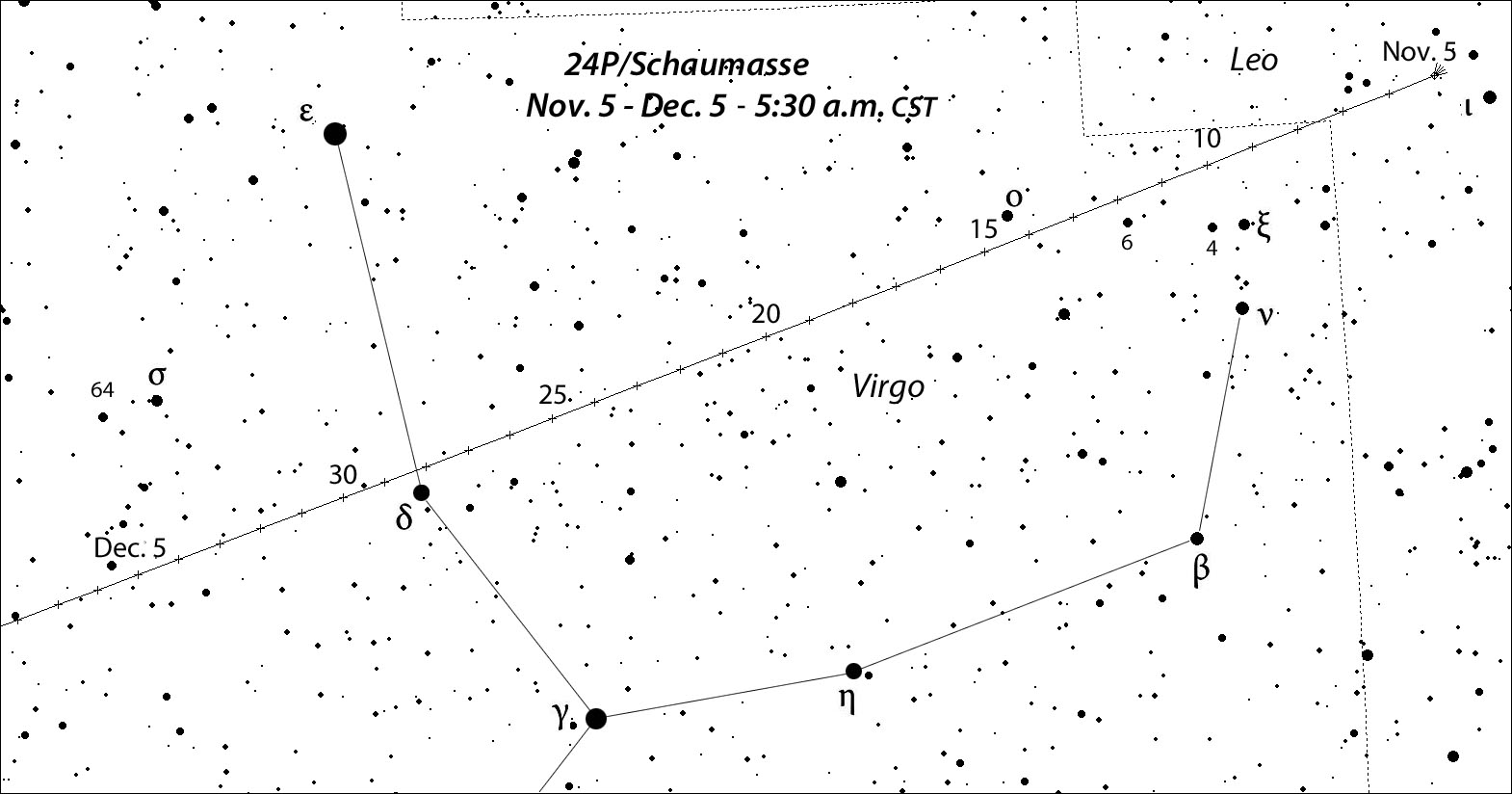
Chris Marriott's SkyMap software
24P/Schaumasse, which returns every 8.2 years, rounds out 2017 with a morning appearance at magnitude +10–10.5 in November and December while tracking across the "Cup" of Virgo, home to hundreds of galaxies, including this mobile lookalike.
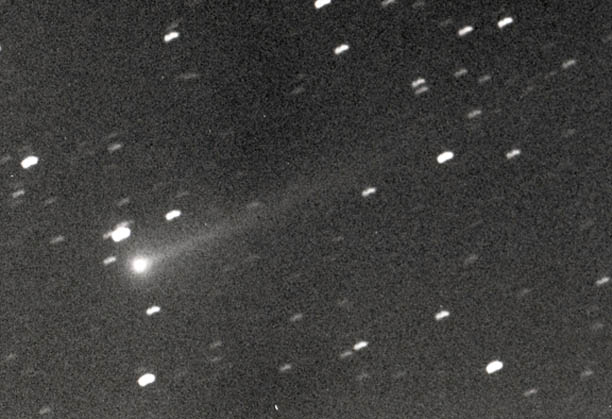
Michael Jaeger
Finally, let's not forget the quixotic, exotic and alphabetic 29P/Schwassmann-Wachmann, known for frequent outbursts that can take it from magnitude +14 or +15 to +10 or +11 overnight. You can watch for it beginning in May and watch all the way through year's end as it crawls across northern Capricornus into Aquarius.
No matter what your instrument — naked eye, binoculars, or telescope — 2017 shows promise in being a bountiful year for comet lovers. And that doesn't even include new comets in 2017 that are just waiting to be discovered!
 28
28








Comments
Jean Loup
January 4, 2017 at 1:40 pm
So the inactive "interactive Sky Chart" will no longer exist... the Stellarium link (by the way) is excellent!! Thank you don Bob.
You must be logged in to post a comment.
Bob KingPost Author
January 5, 2017 at 9:43 am
Thank you, Jean. Stellarium is a very nice program and will be even better once the creators add in the ability to create a comet or asteroid path. Not sure what you mean about the Interactive Sky Chart. Here's a link to an interactive sky chart: https://neave.com/planetarium/
You must be logged in to post a comment.
George Gliba
January 5, 2017 at 5:50 pm
Happy New Year Bob,
Observed comet 45P/Honda-Mirkos-Pajdusakova at 6:30 PM EST last might. It was near
the star theta Cap and was fairly easy to see in 12x63 bimoculars in excellent skies with
good horizons at Mountain Meadows, West Virginia. A short tail was also noticed. It was
very lovely seen just above the distant mountains. It was about 7th magn. and had a short
dust tail.
G.W, Gliba
You must be logged in to post a comment.
Bob KingPost Author
January 5, 2017 at 8:49 pm
Hi George,
Not bad considering the moon was at first quarter last night. Thank you for sharing your observation!
You must be logged in to post a comment.
P.Michael-Hutchins
January 7, 2017 at 8:39 am
I only read this piece twice, but I didn't find anything that is actually likely to be binoculars-visible, unless his horizon is that that's available from the top of Mt. Washington.
Given that, I can't see why anyone thought that "Bright Comet Prospects for 2017" was a reasonable title for this article. I'm very disappointed, and really didn't need to waste my time getting there.
You must be logged in to post a comment.
Bob KingPost Author
January 7, 2017 at 11:12 am
Michael,
Any comet 7th magnitude or brighter is easily within range of ordinary 10x50 (or even 7x35) binoculars for observers under reasonably dark skies unless it's close to the horizon. There have been numerous observations of 45P/H-M-P in binoculars the past few weeks and even some of U1 NEOWISE. Many amateurs, including myself, routinely see mag. 8.0 comets in 10x50 binoculars - at least when they're well-placed. Since bright comets are uncommon, one that reaches 6th to 7th magnitude would be considered "bright." Far more comets are mag. 10 and fainter.
You must be logged in to post a comment.
KatMK
February 26, 2017 at 7:29 pm
Waa, waa! Unless you are in a deep valley I don't know what you are complaining about. I spotted P2/Encke with my bare eyes while I was walking my night shift as a security guard. I saw that it was double the size of the planets and knew it had to be a comet or a supernova. And since a supernova is so rare and nothing was on the news about it then it was a comet. This is what has rekindled my interest in sky watching again. Now if I can only remember where I have put the binoculars that I used to have. By the way the easiest way to spot this one is to look to the west just after the sun has set. It appears clear in the sky before the planets and stars begin to shine.
You must be logged in to post a comment.
Bob KingPost Author
February 26, 2017 at 7:51 pm
Hi Kat,
What you sighted was the planet Venus, not 2P/Encke. The comet's about 5 degrees SW of Venus and much too faint to see with the naked eye. Binoculars or a telescope will nab it.
You must be logged in to post a comment.
robert-simpson
January 7, 2017 at 9:06 am
The chart for Neowise does not show the comet's path.
You must be logged in to post a comment.
Bob KingPost Author
January 7, 2017 at 11:24 am
Robert,
I only plotted U1 NEOWISE into early January because it will be lost in twilight around that time. That's the reason the path cuts off at the horizon and faces east. If it were visible longer, like the other comets shown, I would have created a longer path with north up. For instance, from latitude +40°, the magnitude +7.7 comet is only 9° high an hour before sunrise in morning twilight on Jan. 8. That shrinks to 3° by Jan. 12. In hindsight, I could have added a few additional mornings and continued the arc to say, the 11th (5° altitude). But even this would be a very difficult observation for most observers.
You must be logged in to post a comment.
George Gliba
January 7, 2017 at 11:17 am
It was fairly easy to see with my 12x63 binoculars from near the top of South Branch Mountain
in Mathias, West Virginia. I would even go so far as to say it was "easy to see".
You must be logged in to post a comment.
Bob KingPost Author
January 7, 2017 at 11:26 am
George,
Are you referring to 45P?
You must be logged in to post a comment.
George Gliba
January 7, 2017 at 12:17 pm
Yes. I will look at it again tonight if it clears. I agree with your comments about
the visibility of comets in binoculars. I knew a famous NASA scientist who was a
comet expert who complained that he couldn't find a fairly bright comet with his
binoculars. I was tempted to tell him I found that hard to believe, but decide to
let the comment go unchallenged. The lesson here is the importance of observing
experience.
You must be logged in to post a comment.
Bob KingPost Author
January 7, 2017 at 4:37 pm
Hi George,
Experience helps as you mentioned as does a fairly dark sky (no need for it to be perfect) and a good map.
You must be logged in to post a comment.
George Gliba
January 7, 2017 at 7:59 pm
I was able to observe comet 45P/H-M-P in my 12x63 binoculars this evening but no tail was noticed,
probably due to the bright moonlight. However, the head of the comet looked brighter and more
stellar in appearance than three nights ago. The weather conditions on the mountain were somewhat brutal, with a nasty -5 F. windchill. Brrr.
You must be logged in to post a comment.
Bob
January 9, 2017 at 4:48 pm
Bob King ...
Thank you for another interesting article. The holidays kept me away for a few weeks. Now I hope to be back among your reader fans.
The last comet I saw was a few years ago from my driveway. Not sure which comet. However, that comet observation was made looking at the western sky through a pair of 25x100 binoculars, mounted on a parallelogram, lying back in a zero gravity lounge chair. My neighbors kept slowing down as they passed my house -- a few of them gave me some friendly honks.
I will have to print your article, make a few notations, and fiddle with my parallelogram setup again. Ha! Ha!
...Bob
Kentucky```
You must be logged in to post a comment.
Bob KingPost Author
January 10, 2017 at 9:18 am
Thanks Bob P. I think you'll be putting those binoculars to very good use this year.
You must be logged in to post a comment.
Graham-Wolf
January 11, 2017 at 4:59 pm
Hi Bob... great article, and several interesting condidates for looking at, with 50mnm Bonics in dark Lm 6.0 or better skies... OK, maybe "tone it down"to mid 5th Mv. Nice Comet Finder-Charts too. Had already done tghis a few weeks ago in my observing notebook, but great to see you've been strategising along similar lines to myself!
45p/H-M-P continues to pleasantly surprise. Great to hear several of you have seen it over the Xmas New Year period. It's been passing close to Theta Cap lately. My latest efforts are below.. it went intio outburst just a few days ago, after you wrote this latest article of yours.
Jan 04.425 UT Mv 7.0 5 arcmin coma DC 5 10x50B Finnie Road Intersection.
05.427 UT Mv 6.4 6.8 " " DC 8 20x80R " " "
06.426 UT Mv 5.9 5 " " DC8/9 10x50B " " "
07.439 UT Mv 5.9 6 " " DC6/7 10x50B Scroggs Hill Summit Trig.
FINNIE ROADS INTERSECTION= 45.912004 S, 170.355570 E.
SCROGGS HILL SUMMIT= 45.917015 S, 170.312337 E.
Took a line from Mars through Venus, then down to Theta Cap (UP-Down, Right-Left for my southern latitudes). I then slightly offset to the comet. For my comparison stars, I used the AAVSO-VSP website and did a Custom Chart (20df MLim 10, around Theta Cap). Solar Elongation was some 26 to 28 deg. Rain showers and storms since then, to say nothing of the pollution of a Full Moon!! Crikey.
Regards from 46 South, NZ. Graham W. Wolf.
You must be logged in to post a comment.
SNH
January 20, 2017 at 3:19 pm
Very nice article Bob and thanks for the fame! Since I can see magnitude +8 comets under good conditions in my 7x35 binoculars (bigger binoculars always give a better image, though), I tend to think of any comets between magnitude +7.0 and +9.0 to be "bright". Any between +5.0 and +7.0 I tend to think of as "really bright" (usually naked eye for me!) while any brighter than +5.0 I tend to think of or label as "super bright". So I agree with your choice of article title at my current skill level. However, when I was first starting out, comet Lulin was the first comet I saw in my 7x35 binoculars and even though I found it difficult then, it was sixth magnitude and would have been visible naked eye to me now!! It all depends on your observing level and skill star-hopping with binoculars. Good article! Looks like I'm going to see a "ton" of new comets. Yah!
You must be logged in to post a comment.
Graham-Wolf
January 23, 2017 at 6:43 pm
Hi Bob.
Looks like 45p will reappear (post conjunction) ~ Feb 10th, next month. From 46 South New Zealand, 45p will be at RA 17:33:22.74, DEC +19:04:48:00, near 93 Herculis. At 5:30 am NZDT, it will be just 2.3 deg above NE horizon from Pikiwara summit trig, overlooking Mt Grand at the back of Abbotsford/Kaikorai. At 5:40am, this increases to 3.75 deg alt, and 5 deg 11 min alt at 5:50am. Sarin/65 Her/HIP 84379 is Mv 3.10, and 55 Oph/HIP 86032 is Mv 2.05. You should find 45p almost exactly halfway between these two stars. At 05:38 NZDT, 45p passes between HIP85917 (Mv 5.65) and HIP 85869 (Mv 7.55) over a 2 minute period. All calculated using Stellarium 0.15.1.1 (released Jan 2nd). The comet should lie some 4 arcmin below HIP 85869 at 5:38am NZDT (NZ terrestrial orientation). The Full Moon rises near the same spot at about the same time 2 days later, so your "window" is really Feb 9 -12th. 10x50 Binocs will do in a ZLM 6 - 6.5 sky, but I'll be taking my Polarex 20x80 Spotterscope (2 df FOV) with me by foot to the summit. My Meade GOTO 'scope has been fully reconditioned since I bought it 2nd hand just over a week ago. It runs great at f4 with a SV15 (70af), and 20mm termi-nagler (80af) 1 1/4 inch oculars. Hope this info helps your readers, Bob. Regards from 46 South, NZ. Graham W. Wolf.
You must be logged in to post a comment.
Bob KingPost Author
January 23, 2017 at 8:57 pm
This is great, detailed information for southern observers, Graham. Thank you! Like you, I'm eager to see the comet again.
You must be logged in to post a comment.
Graham-Wolf
January 24, 2017 at 10:54 pm
Thanks for your encouragement Bob.
Always appreciated... astronomy is a pleasure to be freely shared with all.
For comparison stars next month for 45p/H-M-P, you could do a lot worse, Bob, than a customised AASO-VSP Chart (15df MLim 9 centered on Rasalhague will do superbly). OR... alternatively, make it 15df MLim 9 centred on 93 Her (nearby). 45p on Feb 9 -12, will be (terrestrial orientation) some 10 deg below Rasalgaue (Alpha Oph) and some 5 deg to the left, for Kiwi/Aussie observers. For those in Europe and USA, you'll need to flip that orientation upside-down, and back to front. If using AAVSO-VSP comparisons, use the reporting code "AC". If using the HIP (Hipparchus Catalogue) stars, the reporting code is "HP"... as in Hewlett Packard! You'll also see bright planet Mercury low near the Eastern Horizon... 45p will be ~ N.E.
For those with Stellarium, WINDOWS SEARCH on "Stellarium", and enter "ANGLE MODE". All the function keys will then work fine, by sliding the mouse-pointer to the left hand margin. There are plenty of HIP stars to also compare the comet's brightness with. To make life easier:- i recommend setting a default site and FOV, so that the Stellarium software boots immediately to it's "sums" at once. Under Stellarium, enter desired DATE and TIME. Then SEARCH function key, and enter object... in this case 45p/. The cross-hairs will then drift over to the location of the comet against the back-ground stars. Use your mouse-wheel to zoom in to an FOV of say:- 5 deg. This approximate a pair of 10x50B. For a low power telescope, zoom further to ~ 1/2 deg FOV. A good excuse to whip out that 30 or 40mm Plossl / Erfle/ Nagler or ultra-wide what-have-you eyepiece.
Stellarium V 0.15.1.1 also has a 300 page(!!) pdf manual. It's easily downloadable from their website. Hope this all helps your readers out there, Bob. Regards from 46 South, NZ. Graham W. Wolf..
You must be logged in to post a comment.
Graham-Wolf
February 9, 2017 at 7:02 pm
Hello Bob
Thrilled to report a post-conjunction recovery of 45p (H-M-P) yesterday morning from near Pikiwara Summit at McMaster Road Intersection (~ 5:40am NZDT). Skies cleared about 90 mins beforehand, after an all-night overcast. Used HIP 8872 (Mv6.65), HIP 88590 (Mv 7.40) and HIP 88689 (Mv 8.35) comparisons:- all located within 1.5 df centred on the comet. Also had an AAVSO-VSP Custom Chart (20df MLim 9 centred near Rasalhague) as a "back-up". Easily identified mercury ~ 7 deg alt in East, and 93 Her, low and a little left of the comet. No tail structure seen.
Extended a line downwards from Kappa Oph through Rasalhague (Alpha Oph) to the NE horizon. Full Moon had just set in the West, and dawn pollution was starting to limit my LM FOV. Full Moon will be up all night over the next few days. Grrrrr!
Following data obtained, below. A 20 x 16 arcmin elongated coma seen in 12cm f4 Meade GOTO Newtonian at 50x (96 arcmin FOV), to MLim ~ +9. Comet ~ 1.5 deg above horizon, and above Kaikorai Hill trig with Flagstaff Summit (~ 700m) a further 6km to the rear. No obs today as clouded out all night, and scattered showers all morning, so far!
FEB 08.695 UT. 20x80 f4 Spotterscope. 20x HIP Comparisons Mv 6.8 20 arcmin coma DC6
FEB 08.699 UT. 12cm f4 Newtonian 50x HIP Comparisons Mv 6.7 20x16 " coma. DC6/7
Regards from 46 South, NZ. Graham W. Wolf
You must be logged in to post a comment.
Bob KingPost Author
February 10, 2017 at 1:36 am
Way to beat the deadline for seeing the comet in the last possible dark sky before closest approach, Graham!
You must be logged in to post a comment.
Raymond
June 23, 2017 at 9:24 pm
Hello Bob,
Was thinking about trying for 71P/Clark this weekend, do you know if has made mag 10 as predicted?
I just tried https://theskylive.com/71p-info , they have it now in Virgo instead of Scorpius. Was it redirected by aliens since you made this post in January? 😉
You must be logged in to post a comment.
Bob KingPost Author
June 24, 2017 at 9:40 pm
Hi Raymond,
Yes, the aliens lassoed it use for drinking water. You're right - it's still in Scorpius several degrees s. of Antares and currently at mag. 10.5 and moderately condensed. Go for it!
You must be logged in to post a comment.
Raymond
June 29, 2017 at 12:23 pm
Hi Bob,
The skies finally cooperated, so I did catch Clark with my 8" Dob last night. Faint glimmer best seen with averted vision, about 17 degrees altitude. I sketched two positions about two hours apart... working on the AL Comet program. My faintest comet yet! Thanks again for your superb articles and finder charts 🙂
You must be logged in to post a comment.
Bob KingPost Author
June 29, 2017 at 6:06 pm
Raymond,
Wonderful that you found it. And thanks for your kind words. I also found it again in my 15-inch a few nights ago. Very low from Duluth, yet there it was, a little puffy patch.
You must be logged in to post a comment.
You must be logged in to post a comment.